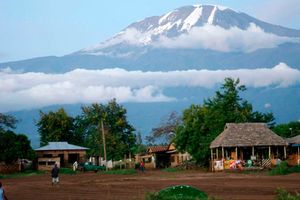Over 2 million people to face water scarcity due to shrinking glaciers

Mount Kenya: The glaciers and ice cap has been disappearing over the years. PHOTO | FILE
What you need to know:
- In Kenya, water levels at the Ngare Ndare River dropped by about 30 per cent in the last 10 years and that is linked to the diminishing mountain glaciers.
The snow caps of East Africa’s mountains are fading faster than before because of climate change.
A new United Nations World Water Development Report shows that in the next 15 years, more than two million people in Tanzania and Kenya will struggle to find fresh water that previously trickled down from the mountains.
The report, which shows the status of the world’s mountain glaciers and water towers, calls attention to the need for protecting the existence of glaciers on Mt Kenya, Kilimanjaro and Rwenzori.
Glaciers, sometimes referred to as river ice, are an accumulation of snow that eventually forms ice and is mostly found in high altitude areas like the mountains.
In the pre-climate change era, glaciers slowly released water during the warmer months, then replenished the ice during colder months.
They have always been a reliable source of fresh water.
The report shows that between the year 2000 and 2023, glaciers lost over 6,500 billion tonnes of ice globally - roughly the amount of water that the entire global population consumes in 30 years.
“Climate change is leading to earlier seasonal snow-melt and reduced glaciers, thereby threatening the availability of water in the summer season. This has serious consequences for populations in downstream basins,” shows the report.
The latest World Meteorological Organization (WMO) report also indicates that the last three years have recorded the greatest loss of glacial ice.
Scientists now worry that the loss will lead to water and food security in some regions.
In East Africa –Mt Kilimanjaro has the largest area of glaciers remaining, covering an area of about one square kilometre. The report shows that the mountain has lost about 90 per cent of its original glacial area.
“Around Mount Kilimanjaro, many canals in the foothills have dried up and the water levels of streams have been decreasing, leading to local conflicts over access to water,” shows the report.
Only about 0.069 square kilometres of glacial area still exists on Mt Kenya, which is estimated to be about 95 per cent loss of glaciers since the year 1900.
A separate study published in the scientific journal Environmental Research shows that the Nothey and Darwin glaciers on Mount Kenya have already disappeared. Lewis glacier, split in two between 2014 and 2016. The study shows that it has now shrunk by 62 per cent in just five years.
“Lewis Glacier had been the greatest glacier on Mt Kenya, but now the Tyndall glacier is of similar size with an extent of 0.025 km2. All remaining glaciers on Mount Kenya are located on the western side of the mountain peaks,” show the study.
In Kenya, water levels at the Ngare Ndare River dropped by about 30 per cent in the last 10 years and that is linked to the diminishing mountain glaciers
“The falling water levels are leading to more conflict as herders and farmers struggle to survive,” shows the report.
Even as human-caused climate change is to blame for the melting glaciers, the report recommends that climate adaptation, especially on water management, should go beyond one country because the impact transcends boundaries.
“Action is therefore needed to prevent further degradation of mountains, to preserve their social and ecological value as well as their function as water towers. As mountain ranges cover multiple countries, cooperation between the countries is needed to ensure proper management,” recommends the report.
hshikanda@ke.nationmedia.com


